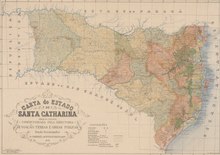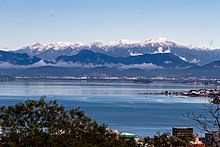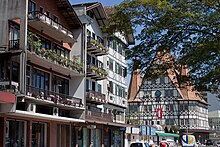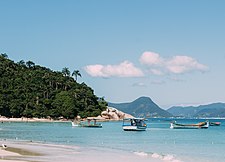Santa Catarina (state)
Santa Catarina | |
|---|---|
| Estado de Santa Catarina State of Santa Catarina | |
| Anthem:Hino do Estado de Santa Catarina | |
 Location map of Santa Catarina within Brazil | |
| Coordinates:27°15′S50°20′W/ 27.250°S 50.333°W | |
| Country | |
| Capital | Florianópolis |
| Largest city | Joinville |
| Government | |
| •Governor | Jorginho Mello(PL) |
| • Vice governor | Marilisa Boehm (PL) |
| •Senators | Esperidião Amin(PP) Ivete da Silveira(MDB) Jorge Seif (PL) |
| Area | |
| • Total | 95,730.684 km2(36,961.824 sq mi) |
| • Rank | 20th |
| Population (2022)[2] | |
| • Total | 7,610,361 |
| • Rank | 10th |
| • Density | 79/km2(210/sq mi) |
| • Rank | 9th |
| Demonym(s) | Catarinense Barriga-Verde(Green-Belly) |
| GDP (nominal) | |
| • Year | 2021 |
| • Total | R$428.571 billion (US$79.5 billion)[3](6th) |
| • Per capita | R$ 56,314 US$ 10,446[3](3rd) |
| HDI | |
| • Year | 2021 |
| • Category | 0.792 –high(3rd) |
| Time zone | UTC-3(BRT) |
| Postal Codes | 87000-000 to 89990-000 |
| ISO 3166 code | BR-SC |
| Website | sc.gov.br |
Santa Catarina(Brazilian Portuguese:[ˈsɐ̃tɐkataˈɾinɐ]) is one of the 27federative units of Brazil.It is located in the centre of the country'sSouthern region.It is bordered to the north by the state ofParaná,to the south by the state ofRio Grande do Sul,to the east by theAtlantic Ocean,and to the west by theArgentine provinceofMisiones.[4]
The state covers an area of approximately 95,730.69 square kilometres (37,000 sq mi), comparable toHungary,and ranking as theseventh smallest Brazilian state by area.[1][5][4]With a population of 7.6 million inhabitants in 2022, it is thetenth most populous state in Brazil.[1]Its capital isFlorianópolis,the second most populous city in the state afterJoinville.AlongsideEspírito Santo,Santa Catarina is one of the two states whose capital is not the largest city.[6]Jorginho Mello,a member of theconservativeLiberal Party,has been the governor of the state since 2023.[7]
It is one of the Brazilian states with the most mountainous terrain, where 52% of the territory is located above 600 metres.[8]According to theKöppen-Geiger climate classification system,Santa Catarina predominantly features ahumid subtropical climate(Cfa) in the coastal lowlands and the lower altitude areas of the plateau, whilst the remainder of the plateau is characterised by anoceanic climate(Cfb).[9]
The state of Santa Catarina is one of the oldest states in Brazil. It separated from São Paulo in 1738, withJosé da Silva Paisserving as its first governor. The state was established to extend Portuguese dominions to southern Brazil, reaching as far as theRio de la Plataregion.[10]It is also the oldest state in the South Region of Brazil, predating Rio Grande do Sul (1807) and Paraná (1853). The state was populated by various peoples throughout its history, such as the indigenous Carijós people of theTupi-Guaranigroup, and later became an important destination forAzorean Portuguese,Italian,German,and other European immigrants.[10]African slaves and their descendants also contributed to the formation of the state's population.[11]
Thesocioeconomicindicators of Santa Catarina rank among the best in Brazil. The stateleads in life expectancyandpublic safety,and boasts the lowest rates ofhomicide,illiteracy,povertyandextreme povertyin the country.[12][13][14][15]It holds also the third-highestHuman Development Index(HDI), thethird-highest GDP per capita,and the third-lowest rates ofinfant mortality.Additionally, it is the federative unit with the least economic inequality in Brazil.[1][16]
Etymology[edit]
Francisco Dias Velho, who arrived on theisland now known as Santa Catarinaaround 1675, is said to have given the place its name. There, he built a chapel dedicated toCatherine of Alexandria,whom, it is claimed, one of his daughters was named after.[17][18]Other authors attribute the origin of the name toSebastian Cabot,who is said to have dedicated the island. At that time, the renowned Venetian explorer and cartographer passed through the area between 1526 and 1527. He is thought to have consecrated it toSaint Catherine,or rather, honoured his wife, Catarina Medrano.[18]The name of the state is derived from that of the island.[17]
The state's native inhabitants are calledCatarinensesorBarrigas-Verdes(lit. Green-Belly).[19][20][21]The origin of the term comes from the waistcoat worn by the soldiers of the Portuguese military forces, under Joaquim Francisco do Livramento. These troops, in 1753, departed from Santa Catarina to fight inRio Grande do Suland secured for Brazil the conquest of theCaptaincy of Santa Catarina.[20][21]
Originating fromCatholicism,the name honours the state's patron saint.[17][18]TheRomansworshipped an ancient deity,Sancus,who ensured promises and oaths were not violated, mandating their fulfilment. From his name comes the Latin verb sancire, "to consecrate". Sanctus, "holy, consecrated, which must, above all, be treated with respect", is the past participle of the verb itself. Etymologically, the name Catherine derives from theGreektermεκατερινα,meaning "pure" or "immaculate".[22][23]
History[edit]
Indigenous peoples, colonial and imperial era[edit]
At the outset of the16th century,the area now known as the state of Santa Catarina was populated by the Carijós, a tribe belonging to theTupi-Guarani group.These Indigenous peoples were catechised (educated and pacified in the Catholic faith) starting from 1549.[24]
Expeditions fromPortugalandSpaincommenced exploration of the Santa Catarina coast in the early years following Brazil's discovery by Europeans.[25]Sebastian Cabot,en route to theRio de la Plata,navigated past theisland then known as Dos Patos,bestowing upon it the name Santa Catarina in 1526. In 1534, John III of Portugal awarded the mainland territories toPedro Lopes de Sousa.Nevertheless, these lands remained largely uninhabited, withJesuits,Spanish, and Portuguese settlers exploring them but failing to establish any permanent settlements throughout the 16th century.[25]
From the outset of Brazil's colonisation, the lands of Brazil'ssouthern regiondid not greatly interest the Portuguese colonisers. This was due to the absence ofprecious metalsand its colder climate (asfrostshindered the cultivation ofsugarcane). The Portuguese only began to take an interest in the region in the mid-17th century.The settlement ofNossa Senhora da Graça do Rio de São Franciscowas established by Manuel Lourenço de Andrade and his friends in 1658. The present-day city was the first permanent settlement in the region.[25]
The settlement ofNossa Senhora do Desterro,on the island of Santa Catarina, was established by the PaulistabandeiranteFrancisco Dias Velho in 1675. At that time, the notable settler was accompanied by his heirs, slaves, and servants. In 1676, the settlement ofLagunawas initiated by Domingos de Brito Peixoto. The Captaincy of Santa Catarina, initially linked toSão Paulo,was founded in 1738. It was separated from São Paulo and incorporated intoRio de Janeiro'sin 1739.[25]
From the 1740s onwards, initiated byAlexandre de Gusmão,minister of KingJohn V,Portugal began a colonisation and settlement project in southern Brazil, aiming to secure possession of the territory disputed by the Spanish. With this objective, immigration fromMadeira Islandand theAzoreswas sought. An insular defensive system was implemented. From 1748 to 1756, around five thousand Azorean immigrants began to populate the island and the coastline of the captaincy. Disputes between Portugal and Spain led to the occupation and destruction of the island of Santa Catarina by Spanish troops in 1777. TheFirst Treaty of San Ildefonsoforced the Spanish to surrender the invaded region.[25]
The Captaincy of Our Lady of the Rosary of Paranaguá was founded by the Marquis of Cascais in 1656.[26]It replaced the Captaincy of Santana,[27][28]which began at the mouth of the Paranaguá Bay and ended in the current city ofLaguna.[27][29][30][31]It is bounded by the Captaincy of Santo Amaro (part of the second section ofSão Vicente) to the north,[27]the salty waters of the Atlantic Ocean to the east, and theGovernorate of New Andalusiato the west.[32][33]These extinct states were delimited by theTreaty of Tordesillas.[32][34]
The captaincy was elevated to the status of a province with the declaration ofindependence of Brazil.The province of Santa Catarina suffered profound consequences from theRagamuffin War,which took place inRio Grande do Sulin 1835. The revolutionaries, led byGiuseppe GaribaldiandDavid Canabarro,invaded Laguna and declared theJuliana Republicin July 1839. Defeated by the troops of theEmpire of Brazil,the rebels left Laguna.[25]The new South American country had a short duration because, when its independence was proclaimed, it stopped paying theRiograndense Republicdue to lack of resources.[35]The last Ragamuffin trenches were demolished in 1840. European colonisation, especially fromGermanyandItaly,was boosted in the second half of the 19th century. The colonies of Dona Francisca, laterJoinville,were established in 1850;Blumenauin 1852; andBrusquein 1860.[25]
Republican period[edit]
The province adhered to theproclamation of the Republic.However, the appointed governor rebelled against the federal government of the time, supporting theFederalist Revolutionin 1893. Desterro became thenaval baseof the revolutionary squadron led byCustódio José de Melo.[25]
The armed conflicts spread throughout the coast of Santa Catarina. Defeated in 1894, the revolutionaries were severely punished by the loyalist troops.Hercílio Luzwas elected governor in 1894 and developed a policy for the pacification of the region and the repair of the infrastructural problems that the state had suffered. Desterro was renamed Florianópolis, in honour ofFloriano Peixoto,following a turn of events that cost the lives of the defenders of the revolution.[25]
TheContestado Warbegan in 1912. This conflict pitted the needy inhabitants of the region located between theNegro,Iguazu,Canoas,andUruguayrivers against the official forces.[36][37][38][25]José Maria de Santo Agostinho, a healer considered sacred, led the backlanders. Moreover,Paranáand Santa Catarina were disputing the region where they lived, which is why the area was called Contestado.[25]The disagreement between the two federative units and the armed conflict of thecaboclosonly ended completely in 1916. Santa Catarina's territory was invaded by the rebellious forces, which came from Rio Grande do Sul, in 1930. However, Florianópolis resisted until the triumph of therevolution throughout the country.[25]
During theSecond World War,it was necessary to address the issue ofNaziinfiltration in the state. In this area, the Brazilian military effort was not compromised by groups of Germans, following a futile attempt. Up until 1945, intervenors governed the state throughout PresidentGetúlio Vargas's administration. Since the 1950s, encouragement for the colonisation of the far west and the centre of the state byItalian-Brazilian settlershas contributed to the progress of Santa Catarina. These settlers came from Rio Grande do Sul.[25]
Geography[edit]
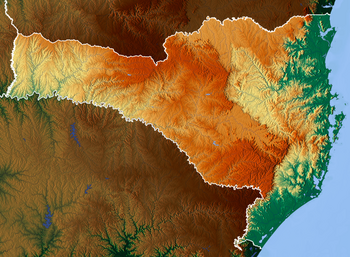
Santa Catarina is one of the three states in theSouthern Regionof Brazil. It is bordered to the north by the state ofParaná,to the south by the state ofRio Grande do Sul,to the east by theAtlantic Ocean,and to the west by theArgentine provinceofMisiones.[4]The state covers an area of approximately 95,730.69 square kilometres (37,000 sq mi), comparable toHungary,and ranking as theseventh smallest Brazilian state by area.[5][4][1]
Its territory is entirely below theTropic of Capricorn,in thesouthern temperate zoneof the planet. It follows theUTC−03:00time zone (Brasília time), three hours behindGreenwich Mean Time.[39]Its extreme points are: to the north, the Saí-Guaçu river in the municipality ofItapoá;to the south, theMampituba riverinPraia Grande;to the east, the Ponta dos Ingleses inFlorianópolis;to the west, the confluence of theUruguayandPepiri-Guazurivers inItapiranga,on the border withArgentina.[40]
Relief[edit]
Santa Catarina has 77% of its territory above 300 metres and 52% above 600 metres, making it one of theBrazilian federative units with the highest relief.Four geomorphological units, ranging from the coast to the interior, form the state's relief: the coastal lowland, the Serra do Mar, thePalaeozoicplateau, and theBasalticplateau.[8]The lowest altitudes are found in the coastal lowland, which encompasses lands located below 200 metres. In the northern part, it is quite wide, extending far inland through the valleys of the rivers that flow from the Serra do Mar. Meanwhile, towards the south, it gradually narrows.[8]
The Serra do Mar occupies the coastal lowland in the western part. In the north of the state, it forms the mountainous edge of a reasonably average plateau. It has a very different feature from what is found in other states such asParanáandSão Paulo.In Santa Catarina, it constitutes a range of mountains, with points above one thousand metres. This range is formed by a group of massifs isolated by the deep valleys of the rivers that descend to the Atlantic Ocean. Behind theSerra do Mar,the Palaeozoic plateau extends. Its flattened area is divided into spaces separated by rivers, which flow eastward. The Palaeozoic plateau decreases in altitude from north to south. In the southern portion of the state, it merges with the coastal plain, since the Serra do Mar does not extend to this region of Santa Catarina.[8]
The Basaltic plateau encompasses a significant portion of the state's territory. Comprisingbasalticsediments (lava flows), interspersed withsandstonedeposits, its eastern boundary is a mountainous edge known as theSerra Geral.In the north of the state, the edge of the basaltic plateau is situated inland. Moving southwards, it progressively approaches the coast until, at the border with Rio Grande do Sul, it starts to descend directly towards the sea. The plateau area is reasonably average and slopes gently westward. The rivers, flowing towards the neighbouring state of Paraná, have carved deep valleys into it.[8]The lands of the mixed ombrophilous forest are infertile, as are the soils of thegrasslands,which are utilised for dairy and beef cattle farming. The soils of thehumid subtropical forestare characterised by their fertility.[41]
Climate[edit]

According to theKöppen-Geiger climate classification system,Santa Catarina predominantly features ahumid subtropical climate(Cfa) in the coastal lowlands and the lower altitude areas of the plateau, whilst the remainder of the plateau is characterised by asubtropical oceanic climate(Cfb).[9]Both have the four seasons well-defined and a rainfall regime evenly distributed throughout the year.[9]
The humid subtropical climate(Cfa)records average temperatures of 20 °C in the lowlands and the Uruguay Valley, and 18 °C in the western extremity of the state. Conversely, the temperate subtropical climate (Cfb) sees average temperatures ranging between 16 and 18 °C. There is a significant difference between summer and winter temperatures, leading to a considerablethermal amplitudethroughout the year. Winters vary from cool to cold, with some regions experiencing about 25 days offrostannually.[9]During this period, the incursion ofpolar air massesis more common, some being stronger and more extensive, causing temperatures to fall below zero in various cities.[42][43]The majority of these cities are located in the Midwest, North Plateau, and South Plateau.[44]Notably,Bom Jardim da Serra,São Joaquim,Urubici,andUrupema,situated on the South Plateau, rank among the coldest municipalities in the country.[45]
A large part ofRio Grande do Sulis situated at latitudes lower than Santa Catarina. Despite this, it is in the higher areas of the Santa Catarina southern plateau where there is a higher occurrence ofsnowfall in Brazilduring the winter months.[9][46]The state also holds the record for the lowest temperature recorded in Brazilian territory by official bodies. The temperature reached −14 °C inCaçadoron 11 June 1952. On the other hand, the highest temperature reached 44.6 °C in Orleans on 6 January 1963. The hottest localities in the state are located in the regions of the southern coast, Itajaí Valley, and extreme west. This is because here lies the city considered the hottest in Santa Catarina,Itapiranga.In these regions, temperatures can exceed 40 °C in the summer or on other extreme occasions.[44]
Hydrography[edit]
The rivers that flow through the state's territory are part of both autonomous systems delineated by theSerra GeralandSerra do Marmountain ranges. The South Atlantic basin is made up of inter-delimited basins, such as those of theItajaí-Açu,Tubarão,Araranguá,Tijucas,andItapocurivers.[9]In the interior of the state, two basins come together to form thePlata basin:that of theParaná,whose most important tributary is theIguazu River,and that of theUruguay River.The latter has as its main tributaries thePelotas,Canoas,Chapecó,andDo Peixerivers.[9]
Fauna and flora[edit]

Fully embedded within theAtlantic Forestbiome, the original vegetation of Santa Catarina encompasses two formations:forestsandgrasslands.[9]
On the plateau, they occur in the form of mixedconiferous(Araucaria) forests with broadleaved trees and, in the lowland and foothills of the Serra do Mar, solely as broadleaved forest. The grasslands appear as scattered patches within the mixed forest. The main ones are those of São Joaquim,Lages,Curitibanos,andCampos Novos.[9]
In the fauna of Santa Catarina, about 600 species of birds,[47]150 mammals,[48]and 140 systematic denominations of amphibians are catalogued.[49]There are 1,150Lepidoptera(butterflies and moths), in addition to the registration of about 2,300vascular plants.[50][51]
Flag[edit]
The flag of Santa Catarina is arectangledivided into three horizontal bands: the upper and lower, sips, and the central, argent. In the middle you can see a sinople rhombus with the coat of arms in the center. On August 15, 1895, Santa Catarina received a flag, designed by José Artur Boiteux. It had thirteen horizontal stripes of sips and argent in a quantity similar to that of districts in the state. Inside the sinople rhombus, jalde stars symbolized the municipalities.[52]
Demography[edit]
| Year | Pop. | ±% |
|---|---|---|
| 1872 | 159,802 | — |
| 1890 | 283,769 | +77.6% |
| 1900 | 320,289 | +12.9% |
| 1920 | 668,743 | +108.8% |
| 1940 | 1,178,340 | +76.2% |
| 1950 | 1,560,502 | +32.4% |
| 1960 | 2,146,909 | +37.6% |
| 1970 | 2,930,411 | +36.5% |
| 1980 | 3,687,652 | +25.8% |
| 1991 | 4,538,248 | +23.1% |
| 2000 | 5,357,864 | +18.1% |
| 2010 | 6,248,436 | +16.6% |
| 2022 | 7,610,361 | +21.8% |
| Source:[2] | ||
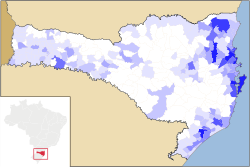
According to the2022 Brazilian censusconducted by theBrazilian Institute of Geography and Statistics(IBGE), Santa Catarina has a total population of 7.6 million and apopulation densityof 79.5 inhabitants per square kilometre. This ranks it as thetenth most populous state in Brazil,accounting for 3.75% of the country's total population.[1]The state's largest city,Joinville,has a population of 616,317, making it the 34th most populous city in Brazil.[53]Meanwhile, its capital,Florianópolis,which is the state's second-largest city, has a population of 537,211, ranking it 39th among Brazilian municipalities by population.[54]
The population grew by approximately 1.3 million inhabitants since 2010, representing an increase of 21.79% between 2010 and 2022. In 2022, around 50.71% of the population (3,859,258 people) werefemale,whilst about 49.28% of the population (3,751,103 people) weremale.[55]
TheHuman Development Indexof Santa Catarina is considered high according to theUNDP.According to the latest Atlas of Human Development in Brazil, released in 2023 with data pertaining to 2021, the state has the 3rd highest HDI among the federal units in Brazil, with an overall index of 0.792. Breaking down the index into indicators of income, education, and life expectancy, the state ranks 4th inincome(with an index of 0.759), 3rd ineducation(with an index of 0.790), and 3rd inlife expectancy(with an index of 0.827).[56][1]Thesocioeconomicindicators of Santa Catarina rank among the best in Brazil. The state leads inpublic safety,and boasts the lowest rates ofhomicide,povertyandextreme povertyin the country.[12][13][14][15]It holds also thethird-highest GDP per capita,and the third-lowest rates ofinfant mortalityandilliteracy.Additionally, it is the federative unit with the least economic inequality in Brazil.[1][16]
|
| Rank | Municipality | Intermediate region | Population | Percentage of total
population |
|---|---|---|---|---|
| 1 | Joinville† | Joinville | 616,317 | 8.09% |
| 2 | Florianópolis†† | Florianópolis | 537,211 | 7.05% |
| 3 | Blumenau† | Blumenau | 361,261 | 4.74% |
| 4 | São José | Florianópolis | 270,299 | 3.55% |
| 5 | Itajaí | Blumenau | 264,054 | 3.46% |
| 6 | Chapecó† | Chapecó | 254,785 | 3.34% |
| 7 | Palhoça | Florianópolis | 222,598 | 2.92% |
| 8 | Criciúma† | Criciúma | 214,493 | 2.81% |
| 9 | Jaraguá do Sul | Joinville | 182,660 | 2.40% |
| 10 | Lages† | Lages | 164,981 | 2.16% |
| 11 | Brusque | Blumenau | 141,385 | 1.85% |
| 12 | Balneário Camboriú | Blumenau | 139,155 | 1.82% |
| 13 | Tubarão | Criciúma | 110,088 | 1.44% |
| 14 | Camboriú | Blumenau | 103,074 | 1.35% |
| 15 | Navegantes | Blumenau | 86,401 | 1.13% |
Ethnicity[edit]
According to the2022 Brazilian census,the population of Santa Catarina was primarily composed ofWhite Brazilians(76.28%),mixed race individuals(19.22%),Afro-Brazilians(4.07%),indigenous peoples(0.25%) andAsian Brazilians(0.18%).[58][59][35][60][61]
Historically, the region was primarily inhabited by theKaingang,Xokleng,andGuaranipeoples, whose populations were reduced since the beginning of colonisation but have survived to the present day. Duringcolonial Brazil,Spanishcolonisers were the first to initiate settlement in the territory of Santa Catarina.[35][60][61]However, the territory later came under Portuguese control, marked byPortugueseimmigration and the arrival ofAfrican slaves.[11]Subsequently, the territory experienced further population growth with the arrival of more Portuguese (especiallyAzoreans) and other European immigrants (Italians,Germans,Poles,Ukrainians,Lithuanians,Jews,Dutch,Belgians,Swiss,Austrians,French,English,Irish,Norwegians,Swedes,Danes,Czechs,Slovaks,Greeks,andRussians), as well as by theJapanese.[35][60][61]
Languages[edit]
In Santa Catarina, two different groups of languages are spoken:indigenous languagesandallochthonous languages,some of which are minority languages.[62][63][64][65][66][67][68]There are three indigenous or native languages:Kaingang,Mbyá-Guarani,andXokleng.[62]With the European settlement of the state, allochthonous or immigrant languages emerged and persist today. These languages includePortuguese(by far the most widely spoken and used language in the state),Talianand otherItaliandialects,[63]High Germanvariants, andLow Germanvariants such as thePomeraniandialect nearBlumenauandPomerode.[64][65]Certain dialects were born in the region. Among them isPortuñol,a combination of Portuguese andSpanishspoken in the border regions withArgentina.[66]And Katarinensisch, part of theHunsrikdialect, originating from the national language of Germany.[64]Other linguistic nuclei on a smaller scale include Spanish,Polish,Lithuanian,Japanese,Arabic,Yiddishand others.[67][68]
Religions[edit]
According to the 2010 population census, the population of Santa Catarina comprisesRoman Catholics(73.07%);Protestants or Evangelicals(20.4%);Spiritists(1.58%);Jehovah's Witnesses(0.74%);Mormons(0.11%); theBrazilian Catholic Apostolic Church(0.17%);Buddhists(0.05%); new Eastern religions (0.04%), among whichMessianicsconstitute 0.03%;Muslims(0.01%);Orthodox Christians(0.07%); followers ofUmbanda(0.14%);Jewish(0.02%);Spiritualists(0.03%); adherents of esoteric traditions (0.17%); Indigenous religions (0.03%); practitioners ofCandomblé(0.09%); andHindus(0.01%). Another 3.27% hadno religion,includingatheists(0.29%) andagnostics(0.6%); 0.29% followed other Christian denominations; 0.21% had an undetermined faith; 0.04% were unsure, 0.04% followed other Eastern religions, and 0.03% did not declare.[69][70]
Economy[edit]
Theindustrial sectoris the largest contributor to the GDP at 52.5%, followed by theservice sectorat 33.9%. Agriculture represents 13.6% of GDP (2004). Santa Catarina exports includeaviculture26.1%, wood products 15.4%,compressors8.5%, cotton 6.8%, andvehicles5.8% (2002). Its share of the Brazilian economy stood at 4% in 2005.[citation needed]

Santa Catarina has one of the highest standards of living in Brazil and is a major industrial and agricultural center. The capital city, Florianópolis, has a diversified economy, being an important location for the technology industry and a major tourist destination. Commerce and services are also very strong in the capital. Cities in Florianópolis metro area, like São José, Palhoça, and Biguaçu are important and diverse industrial centers, as well as strong commercial areas. In the northeast of the state, electric-mechanical, textile and furniture industries are strong; in the west, cattle and poultry breeding predominate, while in the south it is ceramics and shellfish. The corridor between Joinville, Jaraguá do Sul and Blumenau is heavily industrialized—more than 50% of the state's industrial output is concentrated in this small, but highly developed area.[citation needed]
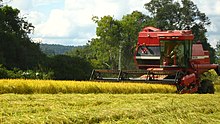

In agriculture, the state stands out in the production of rice, apple and onion, in addition to significant production ofsoy,maize, banana, grape, garlic,barley,wheat andyerba mate.[citation needed]
With only 1.12% of the national territory, Santa Catarina was the eighth-largest producer of maize and the eleventh-largest producer ofsoybeansin Brazil, in the year 2017. When production per unit area is considered, the State becomes the national leader in corn, with an average of 8,100 kilograms per hectare, and second in soybeans, with 3.580 kilos per hectare. In 15 years, there has been a 118% growth in corn productivity and 58% in soybean.[71]In 2019, corn production in the state reached 2.8 million tons (in 2018, Brazil was the third-largest producer in the world, with 82 million tons.[72][73]However, the annual demand for corn in the state is 7 million tons—97% is for animal consumption, especially for pigs and broilers (83.8%), as Santa Catarina has the largest pig population among Brazilian states and the second largest in poultry. The corn deficit is covered by interstate imports, mainly from Mato Grosso do Sul, Mato Grosso, Paraná and Goiás, and from countries like Argentina and Paraguay.[74]In soy production, in 2019 the state harvested 2.3 million tons (Brazil produced 116 million tons this year, being the largest producer in the world).[75]
The state was the second-largest rice producer in the country in 2020, second only to the Rio Grande do Sul,[76]harvesting around 1.1 million tons of the product. Total national production was 10.5 million tons this year.[77]
The three Southern States of the country are responsible for 95% of the national apple production, and Santa Catarina tops, competing with the Rio Grande do Sul. TheSão Joaquimregion is responsible for 35% of the apple planting.[78]
Santa Catarina is also a national leader in the production of onions. In 2017, it produced 630,000 tons, especially in the municipalities of Alfredo Wagner, Angelina and Rancho Queimado.[79][80]
In banana production, Santa Catarina was the fourth-largest national producer in 2018.[81]
Santa Catarina was the third-largest producer of garlic in Brazil in 2018, with a planted area of approximately two thousand hectares. The Curitibanos region is the largest producer in the state.[82][83]
Santa Catarina is one of the few states in the country that cultivatebarley.In the 2007–2011 period, the state had 2.5% of national production. The cultivation was concentrated in the microregions ofCanoinhas(57.6%),Curitibanos(26.5%) andXanxerê(11.5%). It is also one of the few states that cultivate wheat, due to its favourable climate. In 2019 the estimated production of the state was 150,000 tons, still small compared to the 2.3 million tons produced by both Rio Grande do Sul and Paraná. Since the country has to import these two cereals in high volume every year, the state has been trying to stimulate the production of winter grain crops with incentive programs.[84][85][86]
Santa Catarina produced close to 100,000 tons ofyerba matein 2018, mainly in the cities ofChapecóandCanoinhas.[87]

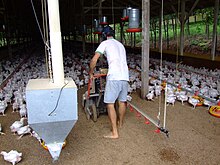
The state had an annual production of about 23,000 tons of grapes in 2019, with 86% of the state production located in the municipalities ofCaçador,Pinheiro Preto,TangaráandVideira.Most of the national production, however, is located in Rio Grande do Sul (664,200 tons in 2018).[88][89]

Santa Catarina is the largest producer of pork in Brazil. The state is responsible for 28.38% of the country's slaughter and 40.28% of Brazilian pork exports. The number of pigs in Brazil was 41.1 million in 2017. Santa Catarina had 19.7% of the total.[90][91][92]
The number of chickens in Brazil was 1.4 billion in 2017. Santa Catarina had 10.8% of the national total, the fourth largest in the country.[92]
Brazil is the fifth-largest milk producer in the world, having produced almost 34 billion liters in 2018, 4% of world production. Santa Catarina was responsible for 8.78% of the national production, almost 3 billion liters of milk. In the production of chickeneggs,Santa Catarina represented 4.58% of the national total, which was 3.6 billion dozens in 2018. The state alone was responsible for 165 million dozens.[93]

In cattle raising, Brazil had almost 215 million head in 2017. Santa Catarina had about 5 million head of cattle in 2018.[92][94]
Santa Catarina was the fifth-largesthoneyproducer in the country in 2017, with 10.2% of the national total.[92]
Fishing plays an important role in the state's economy. The production ofoysters,scallopsandmusselsin Brazil was 20,900 tons in 2017. Santa Catarina was the main producer, responsible for 98.1%.Palhoça,FlorianópolisandBombinhasled the ranking of municipalities.[92]

Santa Catarina is the largest coal producer in Brazil, mainly inCriciúmacity and its surroundings. The production of crude mineral coal in Brazil was 13.6 million tons (Mt) in 2007. Santa Catarina produced 8.7 Mt; the Rio Grande do Sul, 4.5 Mt; and Paraná, 0.4 Mt. Despite the extraction of mineral coal in Brazil, the country still needs to import about 50% of the coal consumed, as the coal produced in the country is of low quality, with a lower concentration of carbon. Brazil's coal reserves are 32 billion tons and are mainly in the Rio Grande do Sul (89.25% of the total), followed by Santa Catarina (10.41%). The Candiota Deposit (RS) alone has 38% of all national coal. As it is the coal of inferior quality, it is used only in the generation of thermoelectric energy and at the site of the deposit. The oil crisis in the 1970s led the Brazilian government to create the Energy Mobilization Plan, with intense efforts to discover new coal reserves. The Geological Survey of Brazil, through works carried out in the Rio Grande, do Sul and Santa Catarina greatly increased the reserves of coal previously known, between 1970 and 1986 (mainly between 1978 and 1983). In 2011, coal accounted for only 5.6% of the energy consumed in Brazil, but it is a strategic alternate source that can be activated when, for example, low water levels in dams reduce hydroelectric power generation. This happened in 2013, when several thermoelectric plants were shut down to maintain the necessary supply, albeit at a higher cost.[95][96]
Santa Catarina had anindustrialGDP of R$63.2 billion in 2017, equivalent to 5.3% of the national industry. It employs 761,072 workers in the industry. The main sectors are Construction (17.9%), Food (15.9%), Clothing (7.4%), Industrial Public Utility Services, such as Electricity and Water (6.9%), and Textiles (6.0%). These 5 sectors constitute 54.1% of the state's industry.[97]
The main industrial centers in Santa Catarina are Jaraguá do Sul, Joinville, Chapecó and Blumenau. The first is diversified, with factories of fabrics, food products, foundries, and the mechanical industry. Chapecó's economy is based onagribusiness.Blumenau concentrates on the textile industry (together with Gaspar and Brusque) and recently also on software. In the interior of the state, there are numerous small manufacturing centers, linked to both the use of wood in industry and the processing of agricultural and pastoral products.


InTextile industry,Santa Catarina stands out. Brazil, despite being among the five largest producers in the world in 2013, and a large consumer of textile and clothing, do not participate proportionately in global trade. In 2015, Brazilian imports ranked 25th (US$5.5 billion), and in exports, it was only 40th in the world. At 0.3% market share in the global textile and clothing trade, Brazil is constrained by uncompetitive pricing compared to producers in China and India. The gross value of production, which includes consumption of intermediate goods and services, by the Brazilian textile industry, corresponds to almost R$40 billion in 2015, 1.6% of the gross value of Industrial Production in Brazil. The South has 32.65% of production, Among the main textile clusters in Brazil, the Vale do Itajaí (SC) stand out. In 2015, Santa Catarina was the second-largest textile and clothing employer in Brazil. It led in the manufacture of pillows and is the largest producer in Latin America and the second in the world in woven labels. It is the largest exporter in the country of toilet/kitchen clothes, cotton terry cloth fabrics, and cotton knit shirts. Some of the most famous companies in the region areHering,Malwee,KarstenandHaco.[98]
InFood industry,Brazil was the second-largest exporter of processed foods in the world in 2019, with a value of US$34.1 billion in exports. The Brazilian food and beverage industry's revenue in 2019 was R$699.9 billion, 9.7% of the country's gross domestic product. In 2015, the industrial food and beverage sector in Brazil comprised 34,800 companies (not counting bakeries), the vast majority of which were small. These companies employed more than 1.6 million workers, making the food and beverage industry the largest employer in the manufacturing industry. There are around 570 large companies in Brazil, which constitute a major proportion of industry revenues.[99][100][101]Companies such asSadiaandPerdigão(which later merged intoBRF),Seara Alimentos(which today belongs toJBS),Aurora(all meat specialists),Gomes da Costa(fish and canned),Eisenbahn BreweryandHemmer Alimentos(specialist in preserves such as cucumber, beet, heart of palm, among others) are based in Santa Catarina.
In theautomotivesector, the state hasGMandBMWplants.[102]
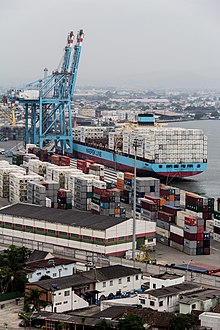
The wood and paper industry is concentrated in (Canoinhas,Três BarrasandMafra) in the north of Santa Catarina, due to raw material availability in the region. In the Serra industries (Rio NegrinhoandSão Bento do Sul),wood-processingworks are carried out, producing various derivatives and final products. The state stands out nationally in the production of wooden furniture. Most companies in this sector are based in these cities, together with Palhoça. The state's industry accounts for 7.5% of the national sector. The state is the second-largest furniture exporter in the country (2014). The Santa Catarina timber industry stands out with a 17.1% share in Brazil. It is among the largest in the country in the production of wooden doors and is a national leader in frames.[103]

Responsible for handling R$6.5 billion in gross value of the Industrial Production of Santa Catarina, the paper andcellulosesector is one of the most important economic vocations in the mountainous part of the state. The sector is 8th highest in exports and 10th in job creation in Santa Catarina, with more than 20,200 vacancies, according to data from 2015. The municipalities ofLagesandOtacílio Costatogether represent about 47% of the exports of the Pulp and Paper sector State role.[104]
Brazil'sceramictile factories are mainly based in the south of Santa Catarina (including the cities ofImbituba,Tubarão,Criciúma,Forquilhinha,IçaraandUrussanga). The state of Santa Catarina also leads the country in the production of crockery andcrystals.
The northeast of the state is notable for the production of moto-compressors, auto parts, refrigerators, engines and electrical components, industrial machines, tubes, and connections. Its compressor production makes it a leader in exports among Brazil's states. It is also an important producer of forestry equipment. In metallurgy, the state has the largest national manufacturer of stainless steel sinks, vats, tanks, trophies, medals, fi xing elements (screws, nuts, etc.), jacketed tanks for fuels, industrial pressure vessels, and malleable iron connections. It is a world leader in engine blocks and iron heads, being Brazil's largest exporter of this product.[105]
In the leather-footwear sector (footwear industry), the state has a production center inSão João Batista.[106]
In thehousehold appliancesindustry, sales ofwhite goods(refrigerators, air conditioning, and others) were 12.9 million units in 2017. The sector had its peak in 2012, with 18.9 million units. The brands that sold the most wereBrastemp,Electrolux,Consul andPhilips.Consul is originally from Santa Catarina, having merged with Brastemp and is now a part of the multinationalWhirlpool Corporation.[107]


The major cities and their respective fields are:
- Florianópolis,technology; tourism; services; commerce; government; education
- Joinville,metal-mechanic; automobile; tourism/events; software development; commerce; plastic; textile; chemistry; education
- Blumenau,textile; software; commerce and beer
- São José,industry; commerce and services
- Criciúma,ceramics
- Chapecó,cattle and poultry breeding
- Lagestourism and wood industry
- Itajai,seaport
- Jaraguá do Sul,electric motors and textile
- Palhoça,industry
- Balneário Camboriú,tourism; commerce
- Tubarão,ceramics
- Brusque,textile
- Rio Negrinho,furniture
- Caçador,furniture; metal-mechanics; agribusiness
- Campos Novos,agribusiness
- Concórdia,Swine industry
- Curitibanos,Agribusiness, wood industry, education
- São Joaquim,tourism
Statistics[edit]
Vehicles:2,489,343 (March/2007); Mobile phones: 3.7 million (April/2007); Telephones: 1.6 million (April/2007). Cities: 293 (2007)[108]
Infrastructure[edit]
Roads[edit]

In 2019, Santa Catarina had 62,871 km of highways, 9,321 km of which were paved, and of these, 556 km wereduplicated highways.[109]
The main highway is theBR-101,which is fully duplicated, passing along the coast, where most of the 25 cities in the state of Santa Catarina with the highest GDP are located.[110]Other major highways in the state areBR-470andBR-280,which are currently undergoing duplication works,BR-116,BR-282,BR-153andBR-158.
Airports[edit]

As it is a state without large metropolises, with cities with no more than 600 thousand inhabitants, Santa Catarina has some important airports spread across the state. Five of them carry out commercial flights:
Florianópolis, the capital, is served byHercílio Luz International Airportfor both domestic and international flights. The traffic has grown significantly and in October 2019, a new airport was opened to serve 2.7 million passengers a year.[111][112]
In Navegantes, there is theNavegantes Airport,the second largest in Santa Catarina and the main gateway to the Vale do Itajaí Region, made up of 12 municipalities with a GDP of R$49 billion, which corresponds to 15.3% of the state's GDP. The airport has a capacity for 3.5 million passengers per year.[113]
In Joinville, there is theJoinville-Lauro Carneiro de Loyola Airport,which serves the largest city in the state of Santa Catarina, with 590 thousand inhabitants. The Joinville region is responsible for 18.3% of the state's GDP and is one of the most important industrial hubs in the development of the south of the country. The airport has a capacity for 800 thousand passengers/year.[114]
In Chapecó, there is theChapecó Airport,which serves the largest city in the west of the state. The airport handles around 500,000 passengers per year.[115][116]
In the area close toCriciúma,Brazil's famous coal region,Jaguaruna Regional Airportwas opened in 2014, which in 2023 handled around 120,000 passengers per year.[117]
Ports[edit]
The state has five specialized ports—Itajaí,São Francisco do Sul,Itapoá, Imbituba and Navegantes—the first two being of great importance. São Francisco do Sul is a major exporter of soy, wood and cellulose, and importer of steel material, such as steel bars and coils, in addition to fertilizers and urea. Itajaí exports a lot of chicken, wood and meat products and imports mechanical and electronic products, chemicals and miscellaneous textiles. Imbituba represents a coal terminal and Laguna, a fishing port. Itajaí had a cargo movement of 18.9 million tons in 2021, and São Francisco do Sul, 13.6 million, being among the ten largest in the country.[118][119]
Tourism[edit]


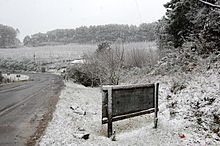
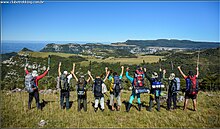
Santa Catarina offers several destinations and events throughout the year: rural tourism, thermal resorts, ecological tourism, and adventure sports, historic monuments and sights, religious tourism, Beto Carrero World and Unipraias parks inBalneário Camboriú,and beach resorts ofFlorianópolis,Laguna,Porto Beloand Itajaí.[120][121]
Some of these sights can only be seen in the off-season, like the snow on the Catarinense Mountain Range—one of the places in Brazil where it snows every year.[122]

Between July and November,southern right whalesvisit the state's coast. The municipality ofTimbóis a center for adventure sports like rafting and canyoning.[122]
The popular festivities take place in October. TheOktoberfest of Blumenauis Brazil's largest and the world's second largest (after Germany'sMunich).[123]
Joinvilleis the host city in July to the widely acclaimed "Joinville Dance Festival", the annual "Festival of Flowers" in November which showcases orchids produced in the region, and several business events in its Convention Center.[124][125]
Florianópolis,the city/island State Capital attracts a large number of tourists during the summer months who visit its 42 beaches.
There are also many smaller resort towns, including the capital of the microlight aircraft tour flightsItapema,Piçarras,Barra Velha,andPenha,home to the famous amusement parkBeto Carrero World.
An interesting collaboration between humans and wildlife has developed inLaguna(birthplace ofAnita Garibaldi,the wife and comrade-in-arms ofItalian UnificationrevolutionaryGiuseppe Garibaldi): a pod ofbottlenose dolphinsdrive fish towards fishermen who stand at the beach in shallow waters. Then one dolphin rolls over, which the fishermen take as a sign to cast their nets. The dolphins feed on the escaping fish. The dolphins were not trained for this behavior; the collaboration has been reported since 1847.[126][127]Southern right whalesalso can be seen in Laguna from the shore during the winter to spring seasons.[128]
The 17,491 hectares (43,220 acres)Turvo State Park,created in 1947, is in the northwest of the state.[129] It contains the Yucumã Falls (Portuguese:Salto do Yucumã,Spanish:Saltos del Moconá), a dramatic waterfall on theUruguay Riveron the Argentinian border. Many tourists come to the park to see the falls, which are 1,800 metres (5,900 ft) long and up to 20 metres (66 ft) high.[130]
Sports[edit]
In the state of Santa Catarina, important athletes were born such as:Gustavo Kuerten,the greatest male tennis player in the country's history;[131]Pedro Barros,one of the most important skaters in the country along with Bob Burnquist;[132]Darlan Romani,world champion in shot put,[133]Tiago Splitter,NBA champion,[134]Fernando Scherer,Olympic medalist and world champion in swimming, andAna Moser,Olympic medalist in volleyball.[135]
Football[edit]
The major football clubs of Santa Catarina are:
Criciuma ECfromCriciúma.Criciúma EC, also known as "Tigre" (Tiger), was champion in theCopa do Brasil(Brazilian Cup) in 1991, the most important championship won by a Santa Catarina team in a very long time. Criciúma is the only team from Santa Catarina that playedLibertadores of America Cup,in 1992, when it was 5th. Criciúma also won the Brazilian 2002 second series and 2006 C series. Criciuma is currently playingCampeonato Brasileiro Série B,the Brazilian national second division.

Figueirense FCblack and white fromFlorianópolis.Its nicknames areFigueira(Fig tree) andO Furacão do Estreito(The Hurricane of Estreito). Its stadium is theOrlando Scarpelli,located in theEstreitoneighborhood in the mainland part of the city. Figueirense is currently playing in theCampeonato Brasileiro Série B,the second division of Brazilian football.
Avaí FC,blue and white fromFlorianópolis.It is also known asO Leão da Ilha(The Lion of the Island). Its stadium is the Aderbal Ramos da Silva, popularly known asRessacada,located in theCarianosneighborhood, in the south part of the island. Avaí is currently playing inCampeonato Brasileiro Série B,the second division of Brazilian football.
Joinville Esporte ClubefromJoinville.It is also known as "Tricolor" or "JEC". JEC won theCampeonato Brasileiro Série B,the second division of Brazilian football, in 2014 and was promoted to theCampeonato Brasileiro Série A,the first division, but currently plays inCampeonato Brasileiro Série C,the third division, after two consecutive relegations.
Associação Chapecoense de FutebolfromChapecó.Chapecoense is playing in theCampeonato Brasileiro Série A,the first and major division of Brazilian football. The club is currently recovering from theloss of virtually all of its first teamin a 2016 plane crash.
Surfing[edit]
Campeche Beach is generally considered to have the best and most consistent waves in Brazil, and in April of each year hosts what is currently South America's only ASP (Association of Surfing Professionals) World Championship Tour professional surfing competition. Brazil has played host to many ASP tour events over the past 30 years. Former contest sites includeRio de Janeiro,Barra de Tijuca, and Saquarema, but in past years have seen the tour set up shop in Florianópolis. Previously held towards the end of the tour, the past few years have seen several ASP world champions crowned in Brazil. In 2004 it was Andy Irons, and in 2005 it was Kelly Slater (who had his 2006 ASP World Title already stitched up by Brazil).
See also[edit]
- Hino do Estado de Santa Catarina
- List of cities in Brazil(all cities and municipalities)
- List of Santa Catarina state symbols
Notes[edit]
- ^abcdefghi"Santa Catarina | Cidades e Estados | IBGE".ibge.gov.br.Retrieved13 February2024.
- ^ab"2022 Census Overview"(in Portuguese).
- ^ab"PIB por Unidade da Federação, 2021".ibge.gov.br.
- ^abcd"Geography of Santa Catarina".Government of Santa Catarina(in Brazilian Portuguese).Retrieved13 February2024.
- ^ab"Áreas Territoriais | IBGE".ibge.gov.br.Retrieved22 April2021.
- ^Frias Filho 1996,pp. 865–866
- ^"Jorginho Mello é o governador eleito com a maior porcentagem do Brasil nas Eleições 2022".G1(in Brazilian Portuguese). 31 October 2022.Retrieved13 February2024.
- ^abcdeGarschagen 2000,p. 82.
- ^abcdefghiGarschagen 2000,p. 83.
- ^ab"History of Santa Catarina".Government of Santa Catarina(in Brazilian Portuguese).Retrieved13 February2024.
- ^ab"Da escravidão à liberdade na Ilha de Santa Catarina"(PDF).Moodle UFSC.31 January 2016. Archived fromthe original(PDF)on 31 January 2016.Retrieved24 February2024.
- ^ab"Estados mais seguros do Brasil: confira o ranking completo".MySide.Retrieved15 February2024.
- ^abRedação 5 (14 August 2023)."Estados mais seguros do Brasil 2023; veja lista".Correio da Amazônia(in Brazilian Portuguese).Retrieved15 February2024.
{{cite web}}:CS1 maint: numeric names: authors list (link) - ^abIBGE,Síntese de Indicadores Sociais 2007: Publicação completaArchived2015-03-19 at theWayback Machine.Tabela 1.4 - Taxa de fecundidade total, taxa bruta de natalidade, taxa bruta de mortalidade, taxa de mortalidade infantil e esperança de vida ao nascer, por sexo, segundo as Grandes Regiões e Unidades da Federação - 2022.
- ^ab"Síntese de Indicadores Sociais | IBGE".ibge.gov.br.Retrieved13 February2024.
- ^ab"Rendimentos de todas as fontes / Índice de Gini / Rendimento domiciliar per capita / A preços médios do ano".cidades.ibge.gov.br.Retrieved13 February2024.
- ^abcHouaiss et al. 1993,p. 10187.
- ^abcGirardi, Giovana."Índios, santos e geografia".Revista Galileu. Archived fromthe originalon 31 October 2013.Retrieved28 September2013.
- ^"Adjetivos pátrios: Veja gentílicos dos Estados do Brasil".educacao.uol.br(in Brazilian Portuguese).Retrieved13 February2024.
- ^ab"Por que os catarinenses são chamados de" barriga-verde "? – Estados e Capitais do Brasil".23 July 2017. Archived fromthe originalon 23 July 2017.Retrieved13 February2024.
- ^abArruda 1988,p. 7129.
- ^"santo | Palavras | Origem Da Palavra".origemdapalavra.br.Retrieved13 February2024.
- ^"catarina | Palavras | Origem Da Palavra".origemdapalavra.br.Retrieved13 February2024.
- ^Arruda 1988,p. 7135.
- ^abcdefghijklmMascarenhas et al. 1998,pp. 5224–5225.
- ^Wachowicz 1995,p. 42.
- ^abcWons 1994,p. 107.
- ^Wachowicz 1995,p. 111.
- ^Wachowicz 1995,p. 39.
- ^Bueno 1999,p. 86.
- ^Cintra 2013,p. 27.
- ^ab"Sistema de Capitanias Hereditárias do Brasil".Archivedfrom the original on 3 October 2016.Retrieved12 February2016.
- ^Mingo, Milagros del Vas (1986).Las capitulaciones de Indias en el siglo XVI(in Spanish). Ediciones Cultura Hispánica, Instituto de Cooperación Iberoamericana.ISBN978-84-7232-397-1.
- ^"Tratado de Tordesilhas - História, mapa e Brasil".Estudo Prático.Archivedfrom the original on 14 January 2016.Retrieved12 February2016.
- ^abcdCabral, Oswaldo R. (1970).História de Santa Catarina(in Brazilian Portuguese). Editôra Laudes.
- ^Dalfré, Liz Andréa (11 July 2018)."Outras Narrativas Da Nacionalidade: O Movimento Do Contestado"(PDF).Archived(PDF)from the original on 12 July 2018.Retrieved24 February2024.
- ^Wachowicz 1995,pp. 189–191.
- ^Wachowicz 2010,pp. 231–232.
- ^"Fusos Brasil sem HV".22 July 2011.Archivedfrom the original on 22 July 2011.Retrieved15 February2024.
- ^"SC - Caracterização do Território".Angelfire.Retrieved15 February2024.
- ^Arruda 1988,p. 7133.
- ^"Sexta-feira amanheceu com temperatura negativa em várias regiões de Santa Catarina".diariodajaragua.br(in Brazilian Portuguese).Retrieved15 February2024.
- ^"Frio em SC: Estado registra 40 cidades com temperaturas negativas".NSC Total(in Brazilian Portuguese).Retrieved15 February2024.
- ^ab"Recordes de Frio – EPAGRI/CIRAM".24 November 2020.Archivedfrom the original on 24 November 2020.Retrieved15 February2024.
- ^"Cidades mais frias do Brasil".Terra(in Brazilian Portuguese).Retrieved15 February2024.
- ^"Onde já nevou no Brasil?".Super(in Brazilian Portuguese).Retrieved15 February2024.
- ^"Aves de Santa Catarina".avesdesantacatarina.br(in Brazilian Portuguese).Retrieved15 February2024.
- ^Cherem, Jorge J.; Simões-Lopes, Paulo C.; Althoff, Sérgio; Graipel, Maurício E. (21 June 2015)."Mastozoología neotropical - Lista dos mamíferos do Estado de Santa Catarina, Sul Do Brasil".Mastozoología Neotropical.11(2): 151–184.Archivedfrom the original on 21 June 2015.Retrieved15 February2024.
- ^Cherem, Jorge J.; Simões-Lopes, Paulo C.; Althoff, Sérgio; Graipel, Maurício E. (21 June 2015)."Mastozoología neotropical - Lista dos mamíferos do Estado de Santa Catarina, Sul Do Brasil".Mastozoología Neotropical.11(2): 151–184.Archivedfrom the original on 21 June 2015.Retrieved15 February2024.
- ^Piovesan, Monica; Orlandin, Elton; Favretto, Mario Arthur; Santos, Emili Bortolon (28 September 2014)."Contribuição para o conhecimento da lepidopterofauna de Santa Catarina".Scientia Plena(in Portuguese).10(9).ISSN1808-2793.
- ^Vibrans, Alexander Christian, ed. (2012).Inventário florístico florestal de Santa Catarina. Vol. 1: Diversidade e conservação dos remanescentes florestais / Alexander Christian Vibrans.Vol. 1. Blumenau: Universidade Regional de Blumenau, Brasil. pp. 99–111.ISBN978-85-7114-330-2.
- ^SImbolos
- ^"Brasil | Santa Catarina | Joinville".cidades.ibge.gov.br.Retrieved15 February2024.
- ^"Brasil | Santa Catarina | Florianópolis".cidades.ibge.gov.br.Retrieved15 February2024.
- ^"Panorama do Censo 2022".Panorama do Censo 2022(in Brazilian Portuguese).Retrieved15 February2024.
- ^"Atlas Brasil".atlasbrasil.org.br.Retrieved15 February2024.
- ^"Censo Demografico 2022. Populacao e domicilios".ftp.ibge.gov.br.Retrieved15 February2024.
- ^ab"Censo 2022 - Panorama".
- ^Lago 1971,pp. 54–67.
- ^abcMATOS, Jacinto Antônio de.Colonização do Estado de Santa Catarina,Tip. de "O Dia": Florianópolis, 1917. 241 p.
- ^abcEL-KHATIB, Faissal.História de Santa Catarina.Curitiba, PR: Grafipar, 1970. 4 v.
- ^ab"Enciclópedia das Línguas do Brasil – Línguas indígenas".17 June 2017. Archived fromthe originalon 17 June 2017.Retrieved24 February2024.
- ^ab"Enciclópedia das Línguas do Brasil – Italiano".Enciclópedia das Línguas do Brasil.12 August 2017. Archived fromthe originalon 12 August 2017.Retrieved24 February2024.
- ^abc"Enciclópedia das Línguas do Brasil – Alemão".13 January 2017.Archivedfrom the original on 13 January 2017.Retrieved24 February2024.
- ^ab"Enciclópedia das Línguas do Brasil – Pomerano".12 August 2017.Archivedfrom the original on 12 August 2017.Retrieved24 February2024.
- ^ab"Enciclópedia das Línguas do Brasil – Espanhol".12 August 2017.Archivedfrom the original on 12 August 2017.Retrieved24 February2024.
- ^ab"Enciclópedia das Línguas do Brasil – Línguas europeias".17 June 2017.Archivedfrom the original on 17 June 2017.Retrieved24 February2024.
- ^ab"Enciclópedia das Línguas do Brasil – Línguas asiáticas".17 June 2017.Archivedfrom the original on 17 June 2017.Retrieved24 February2024.
- ^«Censo 2010». IBGE
- ^«Análise dos Resultados/IBGE Censo Demográfico 2010: Características gerais da população, religião e pessoas com deficiência» (PDF)
- ^Produtividade de milho cresce 118% em 15 anos em SC
- ^"Produção de Milho no Nordeste".Archived fromthe originalon 28 September 2020.Retrieved22 July2020.
- ^Produção de grãos cresce 14% e Piauí se consolida como 3º maior produtor do Nordeste
- ^Produção de milho em 2018/19 em SC chega a 2,8 milhões de toneladas
- ^Confira como está a colheita da soja em cada estado do país
- ^IBGE prevê safra recorde de grãos em 2020
- ^Safra do arroz deve atingir mais de 1,14 milhão de toneladas em Santa Catarina
- ^Safra da maçã deve render 600 mil toneladas em Santa Catarina
- ^"Epagri marca seus 28 anos de fundação com lançamento de cultivar de feijão em Chapecó na quarta-feira".Archived fromthe originalon 29 September 2020.Retrieved22 July2020.
- ^Santa Catarina é o maior produtor de cebola do país e encerra safra com recorde na produção
- ^Produção brasileira de banana em 2018
- ^Epagri inicia nova etapa de programa que garante alta produtividade do alho catarinense
- ^Produtores consideram safra de alho a pior dos últimos 48 anos em SC
- ^A Cevada no Brasil
- ^Área de cultivo de trigo em SC reduz 8% em 2019
- ^Santa Catarina lança Programa de Incentivo ao Plantio de Grãos de Inverno
- ^"Canoinhas é o segundo maior produtor de erva-mate de Santa Catarina, diz IBGE".Archived fromthe originalon 28 October 2020.Retrieved22 July2020.
- ^"Vale do Rio do Peixe produz 86% da uva em SC".Archived fromthe originalon 27 October 2020.Retrieved22 July2020.
- ^Produção de uva no Rio Grande do Sul cai quase 40% frente a 2018
- ^"REGIÃO SUL DO BRASIL É O MAIOR CENTRO PRODUTIVO DE PROTEÍNA ANIMAL DO MUNDO".Archived fromthe originalon 16 October 2020.Retrieved22 July2020.
- ^PPM 2017: Rebanho bovino predomina no Centro-Oeste e Mato Grosso lidera entre os estados
- ^abcdePPM 2017: Rebanho bovino predomina no Centro-Oeste e Mato Grosso lidera entre os estados
- ^Leite e ovos: setores que se reinventam com tecnologia
- ^Novos tempos para a bovinocultura de corte em SC
- ^Carvão Mineral
- ^Carvão mineral no Brasil e no mundo
- ^Santa Catarina Industry Profile
- ^Hering, Malwee, Lunelli e Kyly produzem artigos médicos para doação
- ^A indústria de alimentos e bebidas na sociedade brasileira atual
- ^Faturamento da indústria de alimentos cresceu 6,7% em 2019
- ^"Indústria de alimentos e bebidas faturou R$ 699,9 bi em 2019".18 February 2020.
- ^O novo mapa das montadoras
- ^Página 18
- ^"Setor aposta na" Compre de SC "para estimular consumo de papel e celulose".Archived fromthe originalon 30 June 2020.Retrieved22 July2020.
- ^Página 17
- ^Polo Calçadista
- ^"Um setor em recuperação".Archived fromthe originalon 25 September 2020.Retrieved22 July2020.
- ^Source:IBGE
- ^SISTEMA RODOVIÁRIO ESTADO DE SANTA CATARINA
- ^Lista do PIB das 25 cidades mais ricas de Santa Catarina
- ^Aeroporto Internacional de Florianópolis
- ^Floripa Airport
- ^Sobre Navegantes
- ^Sobre Joinville
- ^Aeroporto de Chapecó já superou a movimentação de passageiros de todo o ano passado
- ^Aeroporto de Chapecó
- ^Roadshow apresenta PPP do Aeroporto de Jaguaruna para investidores na B3
- ^Complexo Portuário de Itajaí e Navegantes excede a marca de 1,6 Milhão de contêineres (TEU’S) movimentados em 2021
- ^As 10 principais realizações e conquistas do Porto de São Francisco do Sul em 2021
- ^Cidades de Santa Catarina
- ^Turismo em SC
- ^abNeve em Santa Catarina deixa Serra com expectativa de "boom" de turistas de última hora
- ^"Top 10 Oktoberfest's around the world".Skyscanner. 19 September 2011.Retrieved5 September2013.
- ^Joinville
- ^Descubra Joinville
- ^The Daily Telegraph(2006),"Brazil's sexiest secret",article retrieved 20 March 2009.
- ^Moti Nissani (2007)Bottlenose Dolphins in Laguna Requesting a Throw Net(video). Supporting material for Nissani's presentation at the 2007 International Ethological Conference. Video retrieved 20 March 2009.
- ^Archived atGhostarchiveand theWayback Machine:"BALEIA E SEU FILHOTE PRAIA DO MAR GROSSO LAGUNA".YouTube.
- ^PES do Turvo(in Portuguese), ISA: Instituto Socioambiental,retrieved11 November2016
- ^Parque Estadual do Turvo(in Portuguese), SEMA: Secretaria do Ambiente e Desenvolvimento Sustentável do Rio Grande do Sul, 19 September 2010, archived fromthe originalon 12 November 2016,retrieved11 November2016
- ^Kuerten profile at ATP
- ^Pedro Barros at COB
- ^Romani profile
- ^Catarinense Tiago Splitter é o primeiro brasileiro campeão da NBA
- ^Veja os catarinenses que já conquistaram medalhas olímpicas
External links[edit]
- Official State of Santa Catarina website(in Portuguese)
- Santa Catarinaon YouTube(in English)
- Guia Catarina – Guia de informações sobre Santa Catarina(in Portuguese)
- Informações sobre as Cidades de Santa Catarina, Eventos, e Diretório de empresasArchived25 November 2010 at theWayback Machine(in Portuguese)
- Bela Santa CatarinaArchived10 February 2009 at theWayback Machine(in Portuguese)






